Signs of Distress
Stress is a normal part of life for any animal. For example, hunger is a form of stress that reminds us to eat, fear is a stress-related emotion that helps us avoid potentially harmful situations. However, when we put our dogs in stressful situations that they cannot escape, problems can occur.
Few dog owners recognize the most common signs of stress and anxiety in their dogs before it is too late. Learning to recognize these common signals can help you prevent serious problems.
NOTE: Context is important! Your dog may yawn when they first wake up, shake off after a bath, or pant on a hot day. But if your dog is in a new or difficult environment and you see these behaviors together, either as a group or in a sequence, and they happen repeatedly, they are very likely an indication that your dog is experiencing stress or anxiety.
Lip and Nose Licking
This type of licking looks very different than when you feed your dog a spoonful of peanut butter and, like all of the signs, are usually accompanied or followed by other signs of stress listed below.
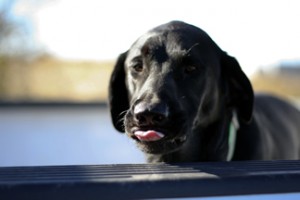
Stress Yawn
This usually happens repeatedly in stressful situations, and is done with more intensity than a “sleepy” yawn.
Panting Yes, dogs pant. But if it is a cool day and your dog has not been engaging in much physical activity and is panting as if she ran a few miles, this is likely a sign of stress.
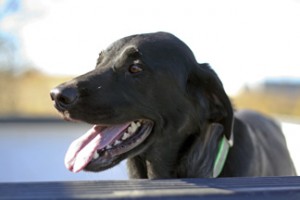
When a dog showing signs of stress suddenly stops panting and closes their mouth, that’s a warning! Dogs often close their mouths shortly before they escalate to a snap or bite.
Pinned Ears
Dogs’ ears vary greatly by breed. Some stand up, some hang low and some are artificially altered to achieve a specific look. But no matter what type of ears your dog has, if they pin their ears back against their head, it could be a sign of stress.
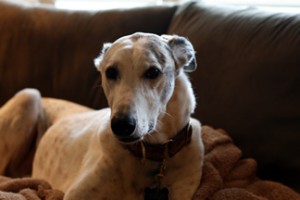
In contrast, Arrow LOVED the attention of the camera and although his ears are pinned back, you see that his eyes and mouth are open and relaxed.
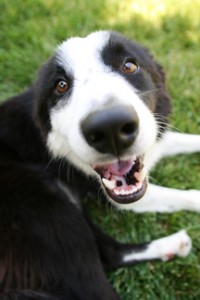
The difference in the expression of the two dogs makes it easier to see which is stress-related and which one is not. Context is everything!
Avoidance
Avoidance can look like many things. Common types of avoidance include:
- Excessive sniffing
- Inattention
- Looking away
- Turning away
Basically, if your dog is in any way avoiding interacting with people or other dogs, he is showing you he is uncomfortable. Avoidance is always a better choice than aggression. If your dog is avoiding interaction with anyone, human or canine, respect that choice. Don’t force your dog to interact if they don’t want to.

This Doberman was not enjoying the attention of these two German Shepherds and is trying to avoid interacting with them. In addition to the lowered head and body, notice the pinned back ears.
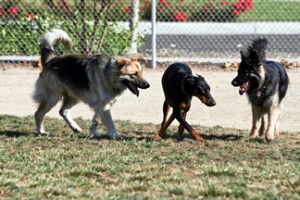
Here, Fiddo turns away from the camera (in addition to licking his nose).
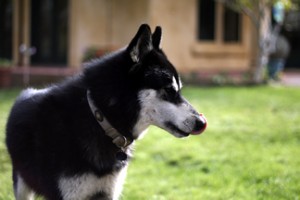
Shaking Off
Dogs will shake their bodies for a variety of reasons, when they are wet or when they first wake up from a nap. But stress-related shaking off almost always follows something the dog finds unpleasant. For example, many dogs shake off right after a veterinary exam. 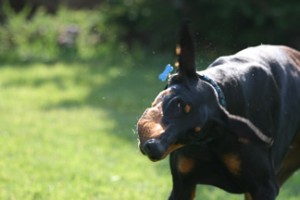
Low Tail Carriage
This is easier to see in some breeds of dogs, than others, obviously. It won’t be as easy to spot in a dog that has a docked tail, for example.
Many people are familiar with the idea that a “tail between the legs” is a sign of fear. But sometimes the tail gives less obvious signals.
Here, the base of this dog’s tail is mid-range, probably the normal position for this dog.
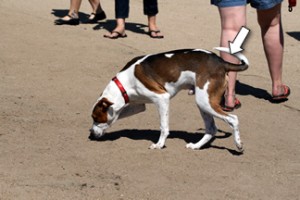
As other dogs approach, however, the base of the tail drops. Also notice her ears and the tension around her mouth.
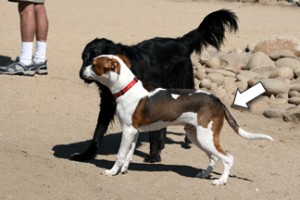
Other Signs
These signs don’t necessarily come across in photos, but are also common signs of stress.
Low body posture
Weight shifted to back legs
Excessive shedding
Excessive whining or other vocalization
Slow or tense movement
Refusal of food (especially when normally food-motivated)
Restlessness or pacing
Inattentiveness to owner
Sweating from paws
Dilated pupils
Tension around eyes and mouth
This Rottweiler looks tense, and her ears are pinned back. She has a lot of tension around her eyes and mouth, as well.

Closed mouth, pinned ears and looking away.

This Border Collie’s ears are forward, indicating it is alert to something in the environment, but the tail is low, the mouth is closed and tense and the dog is leaning backward.
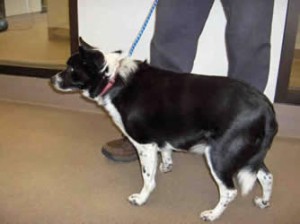
The dog is leaning backward, ears are pinned back and tail is low. Add the dog’s inability to get away because it is chained, and this is a recipe for a bite!
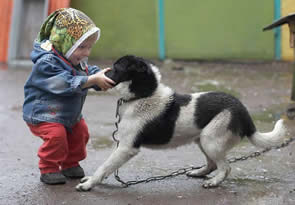
Not all dogs will exhibit all of these signs. The better you get at recognizing your dog’s signs, the better you can help him avoid situations that could cause serious problems, while working with a qualified trainer to learn how to help your dog form better associations in stressful environments.
Pictures and Information from 4paws- www.4pawsu.com/stresssigns.html

Annandale Animal Rescue is licensed under a Creative Commons Attribution-NoDerivs 3.0 United States License.





Leave a response